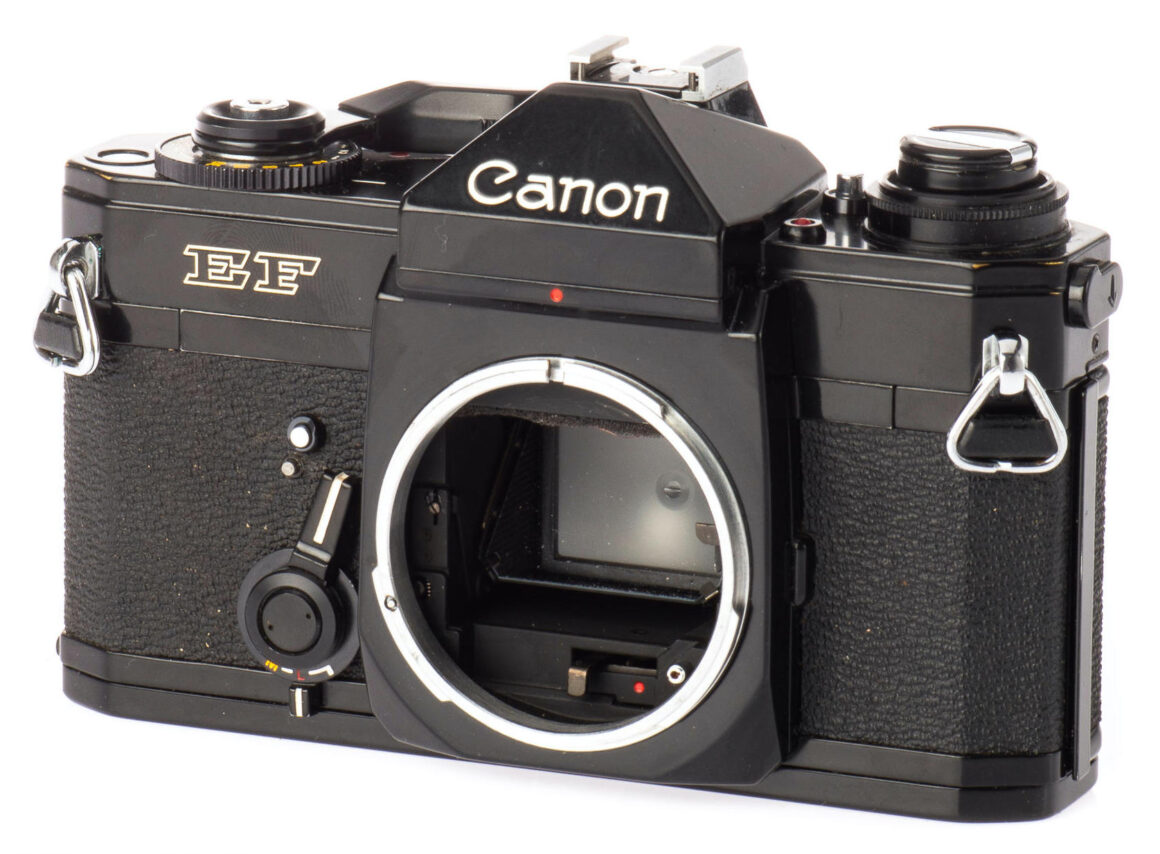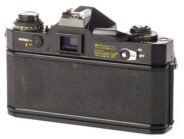Canon EF
35mm MF film SLR camera
Specification
| Production details: | |
| Announced: | November 1973 |
| System: | ● Canon FD (1971) |
| Format: | |
| Maximum format: | 35mm full frame |
| Film type: | 135 cartridge-loaded film |
| Mount and Flange focal distance: | Canon FD [42mm] |
| Shutter: | |
| Type: | Focal-plane |
| Model: | Electronically controlled |
| Speeds: | 30 - 1/1000 + B |
| Exposure: | |
| Exposure metering: | Through-the-lens (TTL), open-aperture |
| Exposure modes: | Shutter-priority Auto |
| Manual | |
| Physical characteristics: | |
| Weight: | 740g |
| Dimensions: | 151x96x48mm |
Manufacturer description #1
This camera’s main feature was the first and last of its kind. It was the Copal Square, a vertical-travel, metal-curtain, focal-plane shutter.
The camera’s specifications and ease of use were ideal for aged users. Just press the shutter button for shutter speed-priority TTL automatic exposure. A silicon photocell was used for full-aperture centerweighted averaging metering. Fast shutter speeds from 1/2 sec. to 1/1000 sec. and bulb were mechanically-controlled while slow speeds from 1 sec. to 30 sec. were electronically-controlled.
Manufacturer description #2
VARIABLE APERTURE AUTOMATIC EXPOSURE CONTROL
a. Any photographer becomes an expert with the EF's simple, effective automatic exposure operation. The user simply sets the ASA, picks the shutter speed, focuses and shoots. The EF selects the aperture for perfect exposures every time.
b. The danger of camera motion is minimal with the EF, because the user picks a shutter speed fast enough to freeze the action, and the camera picks an aperture that will give a perfect exposure.
UNIQUE ELECTRO-MECHANICAL SHUTTER
a. A wide range of exposure situations can be handled easily with the EF's unique electro-mechanical shutter. It covers speeds from 1/2 - 1/1,000 sec. mechanically, so that should battery failure occur, the user still has the use of the most practical range of shutter speeds. For high accuracy, the stepped speeds of 1 - 30 sec. are electronically timed. Because power is only used for the slow shutter speed range, battery drain is minimal in the EF.
INCREDIBLE METERING SENSITIVITY
a. The EF's metering cell is silicon, which is much more responsive and sensitive than conventional CdS cells. It permits metering down to the level of EV-2 (f/1.4, 8 sec.) with ASA 100 film - without the use of any additional accessories.
b. Silicon cells, such as in the EF, do not suffer from "light memory" when accidently exposed to intense light, and therefore retain accuracy at all times.
c. For night photography, the EF's built-in LED (Light Emitting Diode) flashes at one-second intervals while the shutter is open, making it simple and easy to get perfect time exposures.
UNSURPASSED SERIES OF CANON LENSES
a. A photographer can shoot almost anything with the range of nearly 40 Canon interchangeable lenses, from 7.5mm Fish Eye to 1,200mm Super Telephoto. Their definition and performance are unsurpassed.
b. Exclusive Canon Spectra and Super Spectra (multiple) Coatings insure maximum freedom from flare, top color correction and improved contrast.
c. Thanks to the Canon Floating System, FD lenses are as well corrected at near distances as when used for general work.
d. All Canon lenses are as compact as possible, for added convenience in traveling and handling.
INSTANT MULTIPLE EXPOSURES
a. Any number of multiple exposures is possible with the EF, in accurate registration, by simply pushing the multiple exposure button while winding the shutter. During this operation, the frame counter remains stationary.
FULL INFORMATION VIEWFINDER
a. The EF's viewfinder is a true control center because shutter speed, aperture, meter needle and stopped-down index mark are all visible in the finder.
COMPLETE LINE OF ACCESSORIES FOR ANY PHOTOGRAPHIC APPLICATION
a. Canon supplies a complete line of close-up and macro equipment, filters, cases, dioptric lenses and more for the EF. In addition, the Canon Auto Tuning (CAT) System offers fully automatic flash photography.
b. The following Flash-Auto Rings are to be used with the designated lenses:
Flash-Auto Ring A2 - FD 50mm f/1.8, FD 35mm f/3.5, FD 35mm f/2
Flash-Auto Ring B2 - FD 50mm 1/1.4, FD 35mm f/3.5, FD 35mm f/2
USES EASY TO FIND MERCURY BATTERIES
a. For ease in replacement, the EF uses easily-obtainable mercury "button" batteries (2) rather than larger, and often difficult to find, silver oxide cells. In addition, the EF comes with a small holder for two extra batteries, which fits conveniently on the carrying case strap.
Manufacturer description #3
Type: 35mm single-lens-reflex AE (Automatic Exposure) camera with focal plane shutter.
Format: 24 x 36mm.
Standard Lens: Canon FD 50mm f/1.4 S.S.C., Canon FD 55mm f/1.2 S.S.C., or Canon FD 50mm f/1.8 S.C.
Interchangeable Lenses: FD series for AE photography; FL series for stopped-down metering.
Viewfinder: Fixed eye-level pentaprism.
Viewfinder Information: Aperture scale with meter needle, over and underexposure warning marks, stopped-down metering index mark, shutter speed scale and indicator.
Focusing Screen: Split-image/microprism surrounded by ground glass with Fresnel screen.
Field of View: 92% vertical and 93% horizontal coverage of actual picture area.
Magnification: 0.82X at infinity with the standard 50mm lens.
Eyepiece Accessories: Angle finders, magnifier, 4 strengths of eyesight correction lenses, and an eye-cup can be attached.
Mirror: Instant-return type.
Electro-Mechanical Shutter: Vertically moving metal focal plane shutter. 1/2 sec. - 1/1000 sec. and B in 11 steps (mechanically controlled); 30 - 1 sec. in 6 steps (electronically controlled).
Shutter Speed Dial: B, 1-1/1000 sec. (white marking), 1/125 sec. (X sync) (orange marking), 30-2 sec. (yellow marking).
Slow Shutter Speed Indicator: Light Emitting Diode (LED) flashes when shutter speeds from 1-30 sec. are used.
Self-Timer: The built-in self-timer is activated by the shutter button with a time lag of approximately 10 sec. A self-timer lock button prevents unintentional operation.
Exposure Adjustment: Variable Aperture AE with FD series lenses. The aperture is adjusted automatically after shutter speed and ASA are set. Central Emphasis Metering gives an average reading of the screen brightness with more emphasis on the center portion utilizing a wide range Silicon Photocell. Stopped-down metering is possible with FL lenses.
Exposure Meter Coupling Range: EV -2 to EV 18 at ASA 100 with FD 50mm f/1.4 lens: 8 sec. at f/1.4 to 1/1,000 sec. at f/16. At ASA 25 : 30 sec. at f/1.4 to 1/1000 sec. at f/8.
Film Speed Range: ASA 12 - ASA 3200.
Power Source: Two 1.3 volt mercury batteries (Mallory PX625, Eveready EPX625).
Battery Check: LED flashes when battery check button is depressed if power is sufficient.
AE Memory Lock: The f/stop set by the Variable Aperture AE control may be locked-in by pressing a button.
Flash Synchronization: X synchronization at 1/125 sec. and below; M, MF, and FP bulb synchronization at 1/15 sec. and below.
Flash: Built-in hot shoe has direct contacts (for Canon Auto Tuning System). The sync terminal with a built-in cover is on the left end of the camera body.
Canon Auto Tuning (CAT) System: Possible by combination of the Flash Auto-Ring A2 or B2 and the Speedlite 133D. According to the ASA and focused distance, the aperture is adjusted automatically with the selected f/stop indicated in the viewfinder.
Multiple Exposures: Possible by depressing the multiple exposure button while operating the winding lever. Operation may be repeated any number of times. The frame counter is stopped during multiple exposures.
Lens Mount: Canon Breech Lock: FD, FL and R lenses can be used.
Depth-of-Field Preview: Possible by pressing the multi-purpose lever, after manually setting the aperture ring and cocking the shutter.
Automatic Blank Shot Mechanism: Film may be advanced to frame No. 1 simply by using the winding lever. Use of the shutter button is not needed when making blank shots.
Film Loading: Performed by pulling up the rewind crank to open the back cover. Easy film loading with multi-slot take-up spool.
Winding Lever: Single stroke 120° throw. 15° stand-off. The lever moves to the stand-off position when the camera is turned on.
Film Rewinding: Performed by the rewind button and crank.
Frame Counter: S-1-38, automatically resets when back cover is opened.



